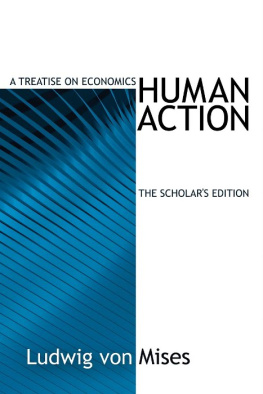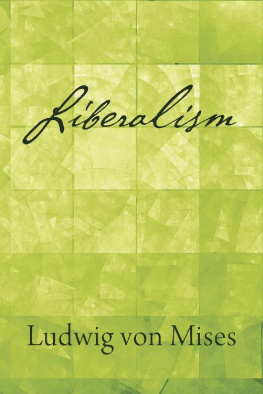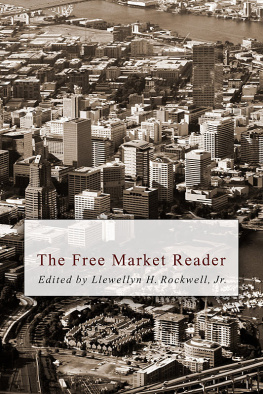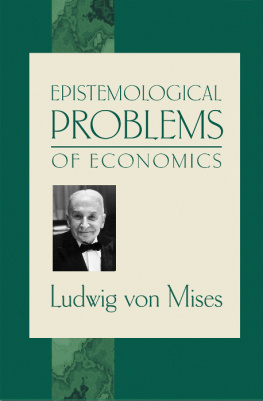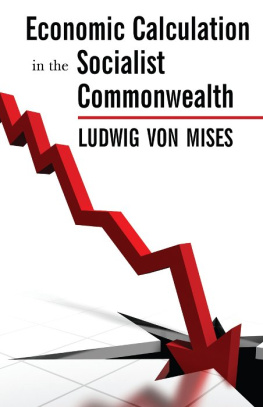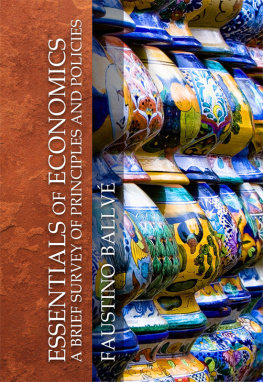Ludwig von Mises - Human Action. A treatise on economics
Here you can read online Ludwig von Mises - Human Action. A treatise on economics full text of the book (entire story) in english for free. Download pdf and epub, get meaning, cover and reviews about this ebook. year: 1963, publisher: Ludwig Von Mises Institute, genre: Science. Description of the work, (preface) as well as reviews are available. Best literature library LitArk.com created for fans of good reading and offers a wide selection of genres:
Romance novel
Science fiction
Adventure
Detective
Science
History
Home and family
Prose
Art
Politics
Computer
Non-fiction
Religion
Business
Children
Humor
Choose a favorite category and find really read worthwhile books. Enjoy immersion in the world of imagination, feel the emotions of the characters or learn something new for yourself, make an fascinating discovery.

- Book:Human Action. A treatise on economics
- Author:
- Publisher:Ludwig Von Mises Institute
- Genre:
- Year:1963
- Rating:3 / 5
- Favourites:Add to favourites
- Your mark:
- 60
- 1
- 2
- 3
- 4
- 5
Human Action. A treatise on economics: summary, description and annotation
We offer to read an annotation, description, summary or preface (depends on what the author of the book "Human Action. A treatise on economics" wrote himself). If you haven't found the necessary information about the book — write in the comments, we will try to find it.
Human Action. A treatise on economics — read online for free the complete book (whole text) full work
Below is the text of the book, divided by pages. System saving the place of the last page read, allows you to conveniently read the book "Human Action. A treatise on economics" online for free, without having to search again every time where you left off. Put a bookmark, and you can go to the page where you finished reading at any time.
Font size:
Interval:
Bookmark:
The Ludwig von Mises Institute gratefully dedicates this
restored Human Action to all its Members who aided in this
historic project, and in particular to the following Patrons:
Mark M. Adamo
Thomas K. Armstrong
The Armstrong Foundation
Richard B. Bleiberg
Dr. John Bratland
Jerome V. Bruni
The Bruni Foundation
Sir John and Lady Dalhoff
John W. Deming
John A. Halter
Mary and George Dewitt Jacob
The Kealiher Family
William Lowndes, III
Ronald Mandle
Ellice McDonald, Jr., CBE, and Rosa Laird McDonald, CBE
William W. Massey, Jr.
Joseph Edward Paul Melville
Roger Milliken
Richard W. Pooley, MD
Sheldon Rose
Gary G. Schlarbaum
Conrad Schneiker
Loronzo H. and Margaret C. Thomson
Quinten E. and Marian L. Ward
Keith S.Wood
The Ludwig von Mises Institute thanks Bettina Bien Greaves for permission to reissue the first edition of Human Action.
Copyright 1998 by Bettina Bien Greaves
Introduction Copyright 1998 by The Ludwig von Mises Institute
Produced and published by The Ludwig von Mises Institute, 518 West Magnolia
Avenue, Auburn, Alabama 36832, (334) 8442500; fax (334) 8442583;
All rights reserved.
ISBN 0945466242
O NCE in a great while, a book appears that both embodies and dramatically extends centuries of accumulated wisdom in a particular discipline, and, at the same time, radically challenges the intellectual and political consensus of the day. Human Action by Ludwig von Mises (18811973) is such a book, and more: a comprehensive treatise on economic science that would lay the foundation for a massive shift in intellectual opinion that is still working itself out fifty years after publication. Not even such milestones in the history of economic thought as Adam Smith's Wealth of Nations, Alfred Marshall's Principles, Karl Marx's Capital, or John Maynard Keynes's General Theory can be said to have such enduring significance and embody such persuasive power that today's students and scholars, as much as those who read it when it first appeared, are so fully drawn into the author's way of thinking. For this reason, and others discussed below, this Scholar's Edition is the original 1949 magnum opus that represents such a critical turning point in the history of ideas, reproduced (with a 1954 index produced by Vernelia Crawford) for the fiftieth anniversary of its initial appearance.
After Bhm-Bawerk's death in 1914, no full-time faculty member at the University of Vienna was working strictly within a Mengerian framework, while Mises's status as a Privatdozent diminished his academic standing. Prior to die geographical dispersal of the school in the mid-1930s, moreover, none of die members of these latter generations had achieved international recognition, particularly among English-speaking economists, on the order of Bhm-Bawerk. After the retirement of Clark, Wicksteed, Fetter, and Davenport from the debate on pure theory by 1920, the School's influence on the mainstream of Anglo-American economics declined precipitously. This left the field of high theory, particularly in the United States, completely open to a Marshallian ascendancy.
In addition, analytical deficiencies internal to the pre-Misesian approach contributed to the sharp decline of the Austrian School after the First World War. The Austrians themselves lacked the analytical wherewithal to demonstrate that the timeless and money-less general equilibrium approach and the one-at-a-time Marshallian approachthe analytical pyrotechnics of the 1930s notwithstandingare both plainly and profoundly irrelevant to a Thus, after a period of remarkable development and influence from 1871 to 1914, by the early 1930s the Austrian School was on the edge of extinction.
Mises was fully cognizant of this unfortunate state of affairs when he emigrated to Switzerland in 1934. Ensconced at the Graduate Institute of International Studies in Geneva, for the first time he could fully focus his attention on academic research. Mises used this opportunity to write Nationalkonomie, a book that intended to revive the Mengerian approach and elaborate it into a complete and unified system. As evidence of the importance that Mises attached to this book, and of the time and energy he poured into it, he wrote very little else in the years leading up to its publication in 1940. Previously an enormously prolific writer, the extent of his output from 1934 to 1939 was comparatively meager: in addition to book reviews, short memos, newspaper and magazine articles, notes, and introductions, there was only one substantial article for an academic audience.
But without an adequate theory of monetary calculation, which ultimately rests upon a unified theory of a money-exchange economy, Mises realized that there could be no definitive refutation of the socialist position. Accordingly, Mises revealed: Nationalkonomie finally afforded me the opportunity to present the problems of economic calculation in their full significance. I had merged the theory of indirect exchange with that of direct exchange into a coherent system of human action.
Thus, Nationalkonomie marked the culmination of the Austrian theoretical approach, and, in a real sense, the rebirth of the Austrian School of economics. It was designed to play a decisive role in reconstructing the whole of economic science in its moment of crisis, including reformulating and unifying price theory, monetary theory, and business cycle theory, and at the same time establishing the correct methodological foundations of the social sciences. Using this mighty architectonic of economic theory, Mises formulated a radical and impermeable defense of laissez-faire policy conclusions that were distinctly unfashionable when the book first appeared.
appeared. It was Mises's crowning intellectual achievement and the sum of his scholarly life. At long last, this book should have established him as the foremost German-language economist and social theorist of his generation.
From the outset, the book was cut off almost completely from the German market, and its Swiss publisher would become one of the countless economic casualties of war. Meanwhile, almost all members of the former Mises-Kreis had likewise left Austria and emigrated to other countries. In their new, foreign, and uncertain environment, they paid little or no attention to it. Thus, Nationalkonomie remained virtually unread. What should have been a moment of immense satisfaction and even triumph, a moment which might have brought about a shift away from the growing Keynesian/Walrasian-Marshallian consensus, and even inoculated the profession against the positivist onslaught of later decades, became for Mises a moment of tragedy and likely the lowest point in his career.
Nine more years would pass until, with the publication of Human Action, Mises would reap some of the rewards that had Yale University Press, headed by Eugene Davidson, had published Mises's Omnipotent Government and Bureaucracy in 1944, on the recommendation of Henry Hazlitt, who was then working for the New York Times as an editorial writer. The success of these works prompted Davidson to send a note to Mises in mid-November that would set the process in motion. Mises and Davidson met on Monday, December 4, at the Roosevelt Hotel for lunch, and made plans for a translation of Nationalkonomie, under the working title Treatise in Economics. Davidson found the idea enticing and solicited further opinions on the matter from a variety of economists and public figures.
U MAN ACTION and Nationalkonomie have the same overall structure of seven parts, and the bulk of the English edition consists of material directly translated from the German. However, significant differences exist.
Next pageFont size:
Interval:
Bookmark:
Similar books «Human Action. A treatise on economics»
Look at similar books to Human Action. A treatise on economics. We have selected literature similar in name and meaning in the hope of providing readers with more options to find new, interesting, not yet read works.
Discussion, reviews of the book Human Action. A treatise on economics and just readers' own opinions. Leave your comments, write what you think about the work, its meaning or the main characters. Specify what exactly you liked and what you didn't like, and why you think so.

